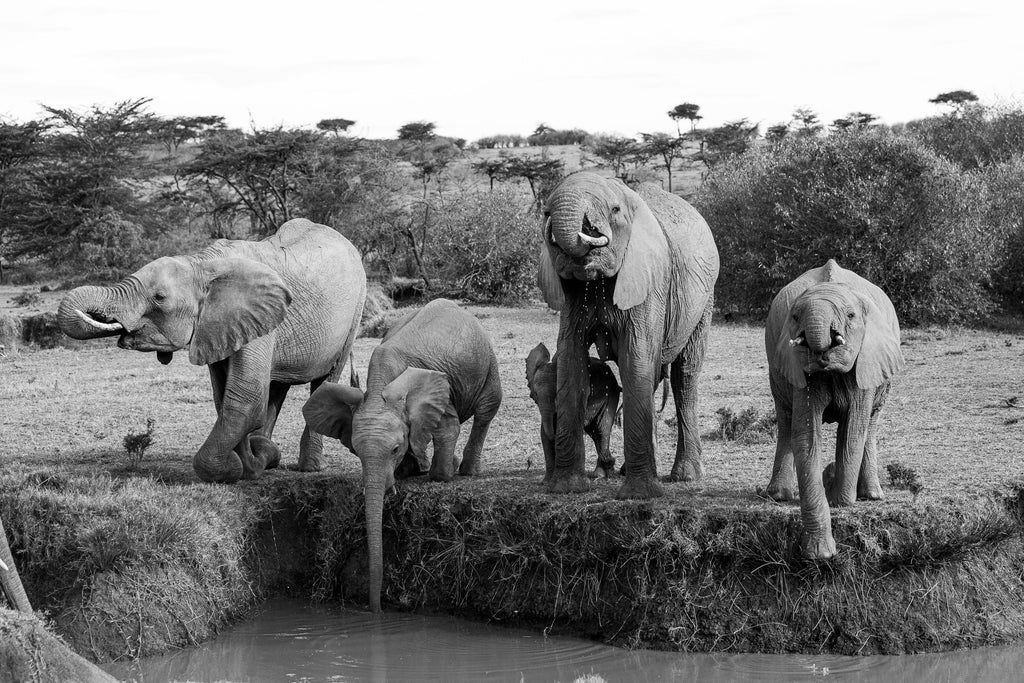Basic Composition in Photography: A Beginner's Guide

Photography is a captivating art form that goes far beyond merely clicking a button. It's about telling stories, evoking emotions, and creating visual poetry through your lens. If you've been following our beginner's guide to photography, you've already learned about the fundamental aspects of camera controls and the importance of lighting. Now, as you embark on your journey to becoming a skilled photographer, it's time to explore the artistic side of the craft. In this post, we'll delve into the world of composition and framing – two cornerstones of photography that will elevate your pictures from snapshots to masterpieces. Whether you're using a professional camera or your smartphone, these techniques will help you create visually stunning and emotionally resonant images. So, let's unlock the secrets of composition and framing, and discover how they can transform your photography.
Composition "Rules"
At the heart of every remarkable photograph lies an understanding of composition. It's the art of arranging elements within your frame to create visually appealing and meaningful images. Whether you're capturing a breathtaking landscape, a candid portrait, or an urban scene, how you compose your shot profoundly influences its impact. Composition is about more than just what's in your viewfinder; it's about storytelling, emotions, and aesthetics. In this section, we'll delve into the essence of composition, exploring the principles and techniques that will elevate your photography to new heights. Regardless of your subject or skill level, mastering composition is the key to making your images truly unforgettable. Here are a few of the most common composition techniques you’ll want to learn.
Rule of Thirds:
One of the most fundamental principles of composition in photography is the rule of thirds. Imagine breaking your image into nine equal parts by overlaying a 3x3 grid. The idea here is to place your subject or key elements along the intersections of these lines or along the lines themselves, rather than dead center in the frame. By doing so, you create a visually pleasing and dynamic composition that draws the viewer's eye into the image. This rule encourages photographers to think deliberately about where to position their subjects, leading to more balanced, interesting, and impactful photographs. Employing the rule of thirds is a quick way to give a basic photograph an extra little oomph and make it more interesting.

Leading Lines:
Leading lines are a powerful compositional tool that can add depth, movement, and visual intrigue to your photographs. These lines can be found naturally in scenes—such as a winding road, a riverbank, or rows of trees—or created intentionally through elements like fences, bridges, or even a person's outstretched arm. The magic of leading lines lies in their ability to guide the viewer's gaze directly towards the main subject or into the heart of the image, making for a more engaging and narrative-rich composition. Starting to play with this technique can elevate your storytelling and create captivating visual journeys within your photographs.

Framing and Balance:
Framing and balance within your composition can transform an ordinary photograph into an extraordinary one. When you consider framing, you're thinking about how to use elements within the scene itself to enclose or surround your subject, effectively drawing the viewer's eye towards it. Whether it's a natural frame like an archway of trees or a man-made one like a window or door, framing adds depth and context to your shot, making it more engaging. Balance, on the other hand, ensures that the visual elements within your frame are harmoniously distributed, creating a sense of equilibrium and visual satisfaction.

Foreground and depth
Creating perspective and depth within your photographs is akin to adding another dimension to your storytelling. In this section, we'll unravel the techniques that give your images a sense of depth and a three-dimensional quality, making them come alive. We'll explore how foreground elements can provide context and scale, while controlling depth of field allows you to selectively focus on specific subjects, blurring the background to draw the viewer's attention. Understanding these concepts will empower you to craft images that invite viewers to step into the scene, making your photography more immersive and captivating. Whether you're shooting sweeping landscapes or intimate portraits, these concepts will enhance your ability to convey the true essence of your subjects.
Foreground Elements
Imagine your photograph as a window into a three-dimensional world waiting to be explored. To achieve this, we'll first explore the crucial concept of foreground elements. These are the elements in the front of your frame, and they play a pivotal role in creating a sense of depth. By including carefully chosen foreground elements – be it a striking rock formation in a landscape or a branch in a portrait – you provide viewers with a visual anchor that offers scale and context, making them feel as if they're stepping right into the scene.
To illustrate these concepts, here are some practical examples. Imagine a landscape photograph where the rocky shoreline serves as a textured foreground, leading the viewer's eye towards a majestic mountain range in the distance. In a portrait, a strategically placed piece of furniture can create depth and dimension, allowing the subject to emerge from the frame. And when shooting lifestyle or documentary portraits, using a key element in the story in the foreground – like moving boxes when a family is unpacking – can create a bit of narrative while also blocking messy or distracting elements in the scene. By mastering these techniques, you'll transform your photography into a captivating journey through space and time, inviting viewers to immerse themselves in your visual storytelling, whether you're capturing the grandeur of a vast landscape or the intimacy of a close-up portrait.

Angles and Perspective
Depth isn't just about what's in the foreground; it's also about perspective. The angle and viewpoint from which you shoot can drastically alter the perception of depth within your photograph. Whether you're shooting from a low angle to emphasize towering skyscrapers or from a high vantage point to showcase sprawling cityscapes, the choice of perspective adds layers and complexity to your images.The viewpoint from which you choose to capture your photographs are like the brushstrokes on a canvas; they shape the narrative and dimensionality of your images.
Imagine you're photographing a subject in the city, and you decide to shoot from a low angle, with the camera nearly at ground level. This perspective can make even a modest building seem towering and imposing, emphasizing the grandeur of urban architecture. Conversely, shooting from a high vantage point can provide a bird's-eye view that unveils the intricate patterns and geometry of a cityscape, presenting a different facet of its beauty.
Furthermore, angles and viewpoints are essential tools for storytelling. When you capture a subject at eye level, you establish an intimate connection between the viewer and the subject, creating a sense of empathy and immediacy. Alternatively, shooting from above can detach the viewer, offering a unique, often cinematic perspective that invites contemplation. Or shooting from below the subject as they look down on the camera can make them look powerful - or even menacing. Whether you're aiming to emphasize scale, create intimacy, or evoke a specific mood, mastering these techniques will add depth, perspective, and a compelling narrative to your photography, allowing you to convey your message with precision and artistry.
Centered and Off-Centered Composition
Central to the art of composition in photography is the deliberate choice between centering your subject and opting for an off-center composition. These decisions can significantly impact the visual narrative and emotional resonance of your images. In this section, we'll explore both approaches, shedding light on when to use them and why they matter.
Center Composition:
Centering your subject involves placing it right in the middle of your frame. This approach can create a sense of balance, stability, and direct focus on the subject. It's often used when you want to highlight the subject's symmetry or when the subject itself is so compelling that it deserves the spotlight. For example, a perfectly centered portrait can accentuate a person's gaze and facial expressions, drawing the viewer's attention straight to their eyes.

Off-Center Composition:
Off-center compositions, on the other hand, introduce dynamism and intrigue into your photographs. Here, the subject is intentionally placed away from the center of the frame, often following the principles of the rule of thirds or other compositional guidelines. Off-center compositions create visual tension, leading the viewer's eye through the image and allowing for more storytelling opportunities. For instance, in a landscape photograph, placing the horizon on the lower third of the frame can emphasize the vastness of the sky and create a more compelling sense of scale.

By exploring the interplay between center and off-center composition, you'll gain a deeper understanding of how to convey different emotions and messages through your photography. Whether you aim to create a sense of stability and directness or to infuse your images with movement and intrigue, these techniques offer you a spectrum of creative possibilities to craft compelling narratives and evoke emotional responses in your viewers. Through practical examples and insights, this section will equip you with the knowledge and skills to make conscious decisions about composition that best suit your photographic vision.
Narrative Through Composition
In the realm of photography, every image has the potential to tell a story and evoke emotions. At the heart of achieving this lies the art of composition. In this section, we will delve into how composition can be harnessed to convey narrative depth and emotional resonance in your photographs.
Composition serves as a potent tool for storytelling. Imagine capturing a photograph of an elderly couple holding hands while walking along a beach at sunset. By positioning the couple in the frame and framing them with the vast expanse of the sea and the warm, setting sun, you instantly create a story of enduring love and the beauty of life's twilight moments. When you deliberately arrange elements within your frame to craft narratives, you can captivate and engage your viewers. Other techniques like juxtaposition of visual elements can add layers of meaning to your photographs.
Photography has the unique power to stir emotions within viewers. Composition plays a crucial role in this process. By choosing elements that convey specific emotions and arranging them thoughtfully, you can create images that resonate deeply. Consider a portrait of a child's genuine, joyful laughter, framed in such a way that their happiness is palpable, - while a moody, monochromatic cityscape that elicits a sense of solitude and melancholy. Additional factors like lighting, color, and the placement of subjects within the frame can be used to evoke emotions and set the tone for your photographs.
In the world of photography, mastering the art of composition and framing is like unlocking the secret to transforming ordinary moments into extraordinary visual stories. Throughout this guide, we've explored the fundamental principles and techniques that will enable you to elevate your photography to new heights. From the rule of thirds and leading lines to depth and dimension, perspective, centering, off-centering, and the power of storytelling, you've gained insights and tools to craft images that captivate, inspire, and resonate. Now, the next step in your photographic journey is just around the corner.
I invite you to take your skills to the next level by enrolling in my brand new course, "Out of the Box: Into Focus," designed especially for beginners like you. It opens for learning on October 1st, but seats are limited so grab your spot during the exclusive sale starting on September 15th. Don't miss this opportunity to delve deeper into the world of photography, refine your craft, and turn your passion into exceptional visual artistry. Join us on this exciting adventure and see your photographic potential come into focus like never before.

Leave a comment